2022 | OriginalPaper | Chapter
15. Economic Impact of Drip Irrigation in India: An Empirical Analysis with Farm Level Data
Author : A. Narayanamoorthy
Published in: The Irrigation Future of India
Publisher: Springer International Publishing
Activate our intelligent search to find suitable subject content or patents.
Select sections of text to find matching patents with Artificial Intelligence. powered by
Select sections of text to find additional relevant content using AI-assisted search. powered by
